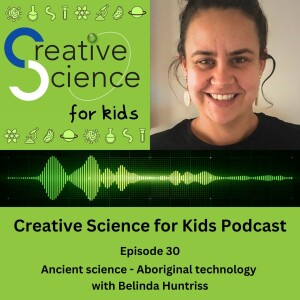
5 days ago
Ancient science – Aboriginal technology with Belinda Huntriss
Let’s step back in time with five fascinating fast facts about how scientists date the ages of ancient artefacts, an interview with Belinda Huntriss, a Worimi woman who is passionate about sharing her knowledge of Aboriginal science and technology, and a tasty sedimentary layer activity for you to try yourself at home.
Presented by Jenny Lynch and Matilda Sercombe. Written and produced by Jenny Lynch. Music by Purple Planet Music. Sound effects by Pixabay.
Creative Science: https://www.creativescience.com.au
Facebook: @creativescienceaustralia
Instagram: @creative_science_australia
Belinda Huntriss: https://freshwater-education.com/
Freshwater Education: Aboriginal education consultancy, professional development workshops, teaching resources, keynote speaker, educator mentoring
Books mentioned by Belinda:
Young Dark Emu – A Truer History by Bruce Pascoe
The First Scientists by Corey Tutt
Episode content:
00:00 Introduction and fast facts
04:07 Deep dive into the Madjedbebe rock shelter in Arnhem Land
05:28 Interview with Belinda Huntriss
12:24 Edible sedimentary layers activity
Edible sedimentary layers activity instructions:
You will need: a bowl, a few spoons, a glass or tumbler, 2 or 3 biscuits or cookies of your choice, custard or chocolate pudding, chopped fruit and sprinkles.
Note: You don’t have to use all of these ingredients to make the sedimentary layers. You might have some tastier ideas you’d like to try.
- Place the biscuits or cookies on a chopping board or in a bowl and make biscuit crumbs by crushing the biscuits with the back of a large spoon.
- Make layers of the ingredients in the glass or tumbler, by adding the ingredients one layer at a time. Start by covering the bottom of the glass with biscuit crumbs. Add a layer of custard or pudding, a layer of chopped fruit and a few sprinkles.
- Repeat the layers, starting again with biscuit crumbs, and keep adding layers until you are happy with your sedimentary layer dessert.
- Use a small spoon to dig into the layers and eat your dessert. You can travel back in time to a few minutes ago when you added the first layer of biscuit crumbs!
Sedimentary layers form when small pieces of rock, sand, and soil settle on top of each other. The layers can also include left over material from plants and animals. As more and more layers are buried, pressure and time causes solid rock to form, and this type of rock is called ‘sedimentary rock’.
No comments yet. Be the first to say something!